How to Make a Ham Cheese and Cracker Tray
What Is Charcuterie?
In the French tradition, charcuterie (pronounced "shahr-ku-tuh-ree") is the art of preparing and assembling cured meats and meat products. The idea of charcuterie has become very popular outside of France, and the term has evolved to include a variety of foods besides meat. A charcuterie board is an assortment of meats, cheeses, artisan breads, olives, fruit, and nuts, all artfully arranged on a serving board. If you want to offer charcuterie on your menu, we'll explain the basics, identify some of the most popular types of charcuterie, and help you make an impressive completed board.
Charcuterie Definition
Charcuterie is a branch of cooking involving prepared meats, such as ham, sausage, bacon, confit, or other pork products. The word originated in France, and it translates to "pork-butcher shop." While the original French translation refers to pork, modern charcuterie boards include other types of food like pate, cheese, crackers, fruit, nuts, and dips.
In French, the cook who prepares the meat is called a Charcutier. The English pronunciation of charcuterie varies slightly from the original French. The correct French pronunciation of charcuterie is "shar-coo-tree."
4 Types of Charcuterie
There are many types of charcuterie meats you can serve to your guests like pate, cured ham, or mortadella. Below we list four unique meat options that would be a great addition to any charcuterie tray:
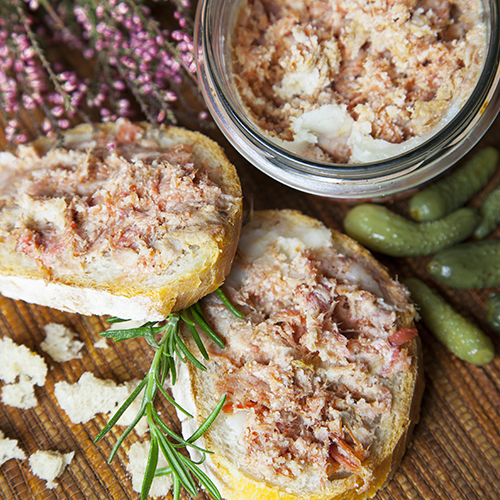
1. Rillettes
Rilletes is a French-style charcuterie similar to pate but with a coarser texture. To make rillettes, meat is slow-cooked until it's soft enough to be shredded. Rabbit, goose, and duck are common types of meat used for rillettes charcuterie.
How Do You Eat It?
Rillettes can be served cold or at room temperature, then spread over bread or toast.

2. Mousse
When talking about charcuterie, mousse refers to a mixture of meat and liver blended in a meat mixer and strained so finely that it takes on a creamy texture.
It's similar to rillettes in that it's a spreadable meat dish, but the main difference is that it has a much smoother consistency that is similar to pate. One of the most popular kinds of mousse is chicken liver, which is often prepared with spices, cream, and even a bit of wine to achieve a rich flavor and silky texture.
How Do You Eat It?
Even though mousse must be cooked before eaten, it's usually served cold and tastes great on toast or even pieces of fruit.

3. Salami
Salami is ground meat mixed with spices (and usually wine), encased in sausage casings, and then dried. There are many styles of salami, some of the most common being Italy's soppressata, chorizo from Spain, and saucisson sec from France.
How Do You Eat It?
The serving method largely depends on the type of salami. Genoa salami lends itself well to being sliced thin on a meat slicer and put on a sandwich. Chorizo is commonly used as an ingredient that adds a robust flavor to cooked dishes and can be found in anything from breakfast to fish entrees to sides of potatoes. Soppresatta is commonly sliced a little thicker and served as an appetizer with cheese and fruit.
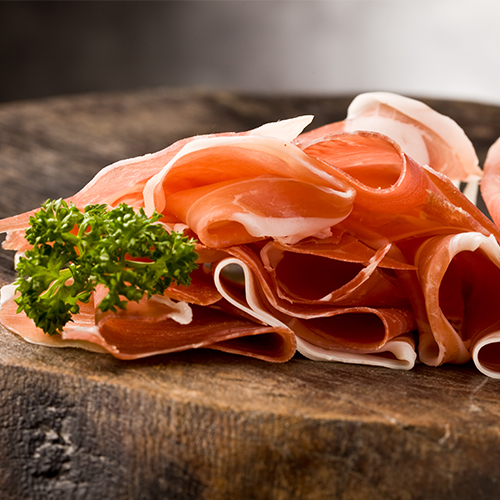
4. Prosciutto
Prosciutto is a fatty cut of meat that's cured in salt and hung to dry over several months. Prosciutto is usually made from pork, but cured lamb, duck, or other meats that undergo the same process can also be considered a type of prosciutto.
How Do You Eat It?
Because of its dense texture, prosciutto is typically sliced very thin on a specialty meat slicer and can be served in a wide variety of ways. You may see it wrapped around fruit or covering other meats and cooked as a crispy outer shell. It's a delicious pizza topping: it can be diced and added to quiche or pasta dishes, and it can be eaten all on its own!
How to Make a Charcuterie Board
An ideal charcuterie board has a good balance of flavors and textures with items that both contrast and complement each other. Here are some tips for making pairings and choosing ideal options for your charcuterie tray:
- Pair a chewy, piquant salami with a rich, smooth pate.
- Complement spicy chorizo with sweet fruits.
- Contrast cold cheeses, fruits, or meats with warm sausage or cheese.
- Limit yourself to one smoked meat option per tray. Smoke has a strong flavor that can easily overwhelm more delicate flavors on the board.
The basic goal of a charcuterie board is to create a pleasing contrast between the different qualities in each morsel. Many charcuterie boards will include sliced baguette, fruit preserves, and even mustard or flavored olive oils to mix up the possible combinations.
Charcuterie Board Portion Sizes
When it comes to portion size, many charcuterie boards will include only about 2 oz. of meat per person. This is assuming that it's being used as a "small plate" being eaten in between meals. For cocktail parties or settings where guests will only eat tapas or hor d'oeuvres, you can increase the size and include larger portions of crackers and bread.
How to Serve Charcuterie
Presentation is an important aspect of serving charcuterie. The appearance of the board and the way the foods are arranged is part of the charm of charcuterie. Natural wood serving boards are a popular option because they give the charcuterie board a trendy, rustic look. If you want to create an upscale aesthetic, slate servingware is an excellent option. For restaurants looking for attractive, affordable, and easy-to-maintain options, melamine serving boards mimic the look of real wood or marble.
4 Styles of Charcuterie Boards
There are a few different approaches you can take while developing a concept for your charcuterie board. You can go with a regional approach and include items that all hail from the same country or town (i.e. you could make an entire board based on the flavors of Alsace, France or Bologna, Italy). Or you can take a more freestyle approach and think about how your favorite flavors and textures would translate onto one board. Here are a few examples of the latter option, to spark your creativity.
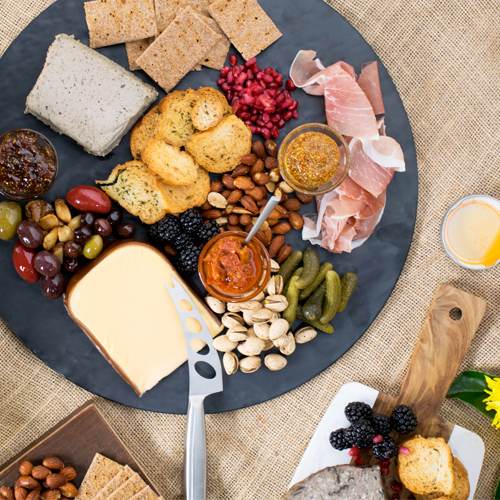
1. Pickles and Spreads
Pickled foods provide a tangy contrast to sweet, smokey meats and cheese. Choose a variety of pickled vegetables like pickled cauliflower, sweet gherkins, or pickled red onion.
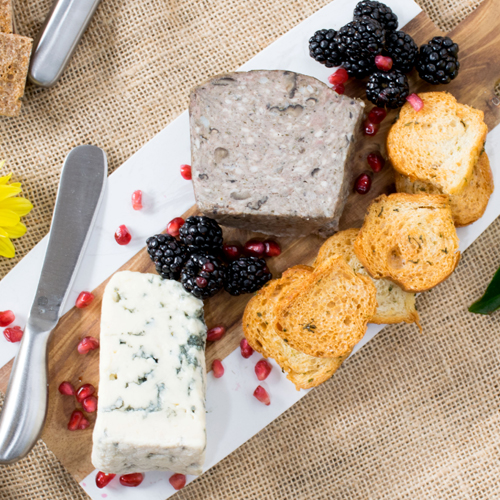
2. Cheese and Fruit
Pairing the right cheese and fruit provides a flavorful contrast of taste and textures. Some classic fruit and cheese combinations are grapes with cheddar, pears with gouda, or cherries with brie.

3. Fresh Veggie and Citrus
Think crunchy fennel and blood orange slices. The bright, fresh flavors of produce balance out heavier, fattier meats like salami.
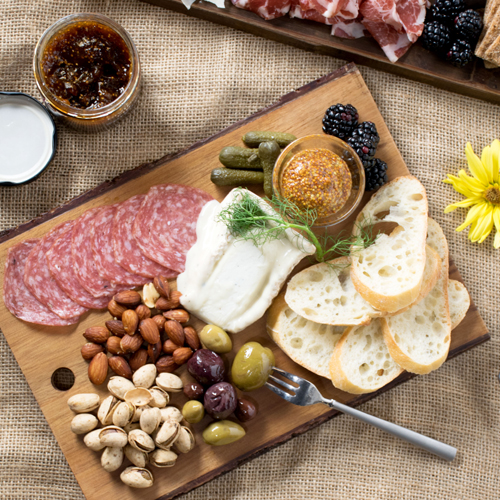
4. Toasted Bread and Meat
Slices of toasted bread provide a delicious vehicle for topping with meats, cheeses, and dips. Classic charcuterie items like prosciutto and fig jam pair perfectly with toasted baguette.
When it comes to making a charcuterie board, there's no right or wrong way. Instead, focus on creating flavor combinations and providing your guests with a memorable dining experience. You can experiment with your charcuterie boards by using creating new and interesting pairings of meats with different types of cheeses. Knowledge of the various ingredients in a standard charcuterie board can help you break the rules in an effective way as you grow more comfortable with the craft of developing a delicious and cohesive board for your restaurant, bar, or cocktail party.
How to Make a Ham Cheese and Cracker Tray
Source: https://www.webstaurantstore.com/blog/2318/what-is-charcuterie.html